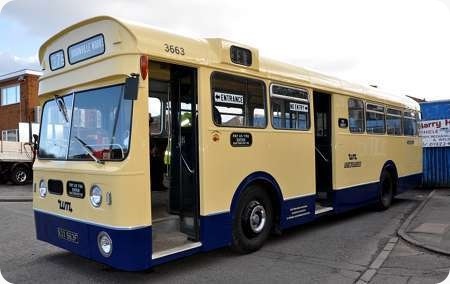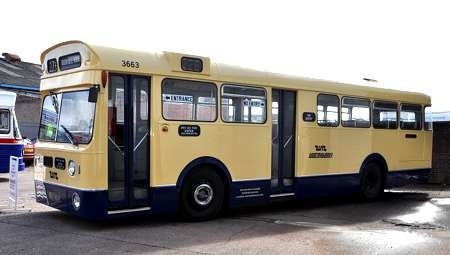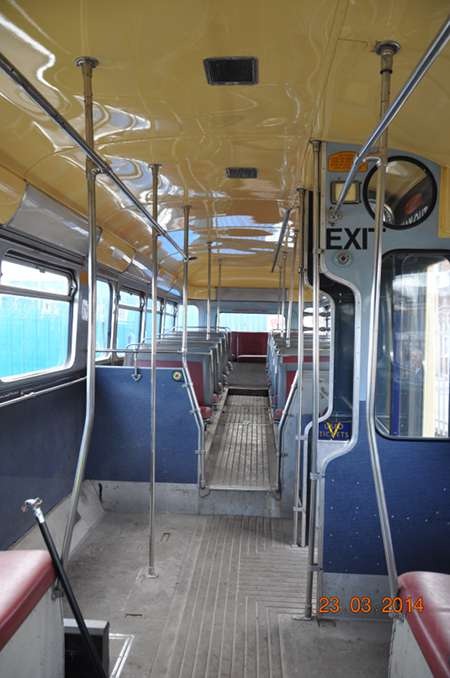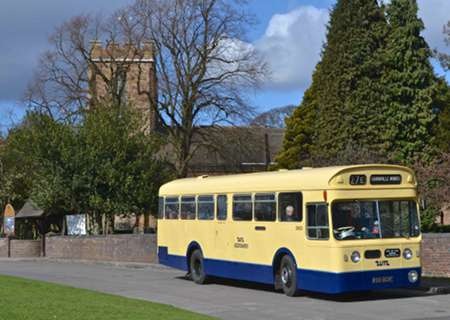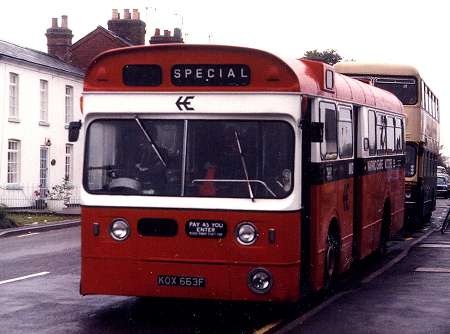Birmingham City – A E C Swift – KOX 663F – 3663
Birmingham City Transport
1967
A E C Swift 505 MP2R
Metro-Cammell B37D+30
KOX 663F, is an A E C Swift 505 MP2R built in 1967 with Metro-Cammell B37D+30 standing bodywork. New to Birmingham and then West Midlands as 3663 it was acquired by Mid Warwickshire Motors before being preserved and has just been fully restored in West Midland livery.
Photograph and Copy contributed by Ken Jones
13/04/14 – 18:30
Another candidate for the Ugly Bus page! Top-heavy treatment of the front end…. Was this for extra headroom? ….and the side route box and blank panel/window by the exit. Does it really have no doors?
Joe
14/04/14 – 07:43
Both sets of doors are open.
Roger Burdett
14/04/14 – 07:43
Slightly less ugly than the same bodybuilder’s effort on the Liverpool Panthers.
Phil Blinkhorn
14/04/14 – 08:44
Doors… I can see a handrail to each right and a well-light at the bottom- but above that I look straight through the bus. Is there room on the left, obstructing the driver’s view?… Now it can be told?
Joe
14/04/14 – 08:44
Two pictures for your consideration
one showing that the vehicle does have doors
and one internal shot showing the standing area.
Ken Jones
14/04/14 – 18:19
Thanks Ken- looks like one flap on each side then? Ceiling marvellous shade of Nicotine, reminiscent of top decks. Is that your silver handled cane?
Joe
14/04/14 – 18:19
Pity it’s ugly – certainly an unbalanced design – because it’s a superb restoration from the photographic evidence. The Liverpool Panthers might beat them in the ugly stakes but the Southport Panthers, with deeper screens, were quite handsome for their time.
David Oldfield
15/04/14 – 06:57
Not my cane and not my bus before anyone asks – they haven’t made a Swift in N gauge yet!
Ken Jones
15/04/14 – 06:57
It looks to me as if Met Cam have used the lower front end of a double deck Fleetline as supplied to Birmingham – probably at the customers request in the interests of standardisation
Ian Wild
15/04/14 – 06:57
I must be fair and agree with David: uglybus maybe, but it looks a lovely job. I have however been staring at Panthers & Swifts on this site and wonder why this bus has so much infilling between screen and peak- look at the Leeds Roes- just enough. Never mind.
Joe
15/04/14 – 06:58
Looking at a photo of a Southport MCW-bodied Panther here //tinyurl.com/m4xqajb, it looks like the same windscreen to me (although in the curved Manchester version rather than the Birmingham vee-form). But I can see three subtle differences which make it fit better. The blank space above the screen is split up by the way it is mounted, the front half of the bus has deeper windows and the remaining height difference is accommodated by the livery application. It just shows what a little thought can do.
Peter Williamson
15/04/14 – 10:49
…..and longer (panoramic?) side windows, Peter. Always make a better impression than multiple short windows. [Only the Y type "got away" with it, but the panoramic side window – normally coaches – version was much better.]
David Oldfield
15/04/14 – 10:51
These buses were built to the operator’s specification using many standard parts in the interest of economy and ease of maintenance. The flat screens for example, like much of the front end treatment, are shared with the BCT double-deck fleet and were used because they were much cheaper to replace than curved ones. The shell is that used to body mainly Panthers, but also some Panther Cubs and some Swifts and is a close copy of the ubiquitous BET design.
It is a great credit to the owners that they have restored this bus, which is now, and arguably always was, an interesting rarity. If we were to judge all historic artefacts on their aesthetic appearance alone, and only retain what looks nice, bearing in mind of course that beauty is in the eye of the beholder, an immediate end would be put to those interminable antiques programmes on the TV!
Let’s hope that the owners don’t read the comments left here – If I were one of them, I would feel insulted.
The bus does look much better in more favourable surroundings, as I’m sure that you gentlemen will agree.
Philip Lamb
15/04/14 – 18:11
I’m not sure why anyone should feel insulted. It is a most attractive restoration of a rather unpretty bus, but a lack of prettiness is no reason not to restore- or I would be rejected by the NHS! As it is, it tells a fascinating tale of fleet management, which has unfolded here- and how this and other operators resolved such questions. Consider the rather odd looking PS1 deckers-utility over looks? Or single deck Fleetlines? Bridgemasters, Wulfrunians were all unpretty but of their time. Was there a balance between appearance and economy through standardisation? Good material for discussion- so we can all be wannabee General Managers!
Joe
16/04/14 – 06:49
Can’t understand why anyone would feel insulted over the ugly bus comments. Preservation of anything is normally for reasons of historic value. Availability, familiarity, rarity are other factors. Looks rarely come into it and shouldn’t have any bearing with a true preservationist
Phil Blinkhorn
16/04/14 – 06:50
Thank you Joe for your balanced comment. There’s no reason for anyone to be insulted by any of the comments on this link – mine or anyone else’s.
There is, of course, a reason for the body being on both Swift and Panther. It’s the same bus. They shared a frame and only the engines and gearboxes were different. It was the first entirely new bus (in 1964) from the Leyland Motor Corporation, after the merger of Leyland and ACV in 1962.
David Oldfield
16/04/14 – 11:09
I consider this bus to be of an interesting – "different" – but perfectly acceptable appearance, especially compared to some of today’s double deckers from certain factories, vehicles which are simply a mass of incongruous bits and pieces disguised to a degree by ghastly "liveries." The Birmingham Swift’s livery is dignified and unsullied in the extreme, and the ceiling material in my view is delightfully restful and attractive and a welcome change from the almost universal garish matt white of today – I’m sure this material was chosen by BCT rather than having anything to do with nicotine Joe.
Chris Youhill
16/04/14 – 18:24
Perhaps David O you should have started your thread with ‘I think it is ugly’ rather than ‘pity its ugly’ that way it is defined as your personal opinion rather than Carte Blanche opinion on the bus as clearly opinion on this bus is divided and just maybe less people may feel a little offended – just my thoughts!
Clearly a lot of time, money and hard work has gone into an excellent restoration of a relatively rare vehicle. I rather like this bus and I would also agree with Ian Wild with regards to the front end treatment.
Richard McAllister
16/04/14 – 18:25
I think some of the difference between this Swift and the Southport Panther are due to the fact that the Panther has a front mounted radiator and therefore needs the attractive grill fitted by Metro Cammell and also has deeper destination apertures which decreases the size of the blank panel above the screen, the deeper windows in the front part of the body also lessen the large side panels aided by the band of colour below the window line which may not look as good on the O/S. To me the use of curved screens on the Panther make little difference to the overall appearance, but the Swift’s restoration is a credit to a huge amount of time and effort by many people WELL DONE.
Diesel Dave
16/04/14 – 19:02
The ceiling colour is similar to that employed by LT on its Routemasters and is there to combat nicotine. This only worked in part. I used to sell a PVC/aluminium product called Tedlar which was supposed to defeat nicotine by being wipe clean but the cost of the product and the cost of cleaning was too much for the 1960s bodybuilders and operators.
Phil Blinkhorn
17/04/14 – 06:29
David’s comment about the windows being shorter than on the Southport Panther has caused me to look at this a little more closely, and I have come to the conclusion that the Swift’s body was designed very much from the inside out. The door apertures are much narrower than on the Panther, and the exit door is mounted further forward. Presumably this was to give the internal layout that the operator desired, but the result is that it would have been impossible to fit longer windows in the front half, and therefore at all (since this was well before the advent of the Borismaster ethos where every bay can be a different size!).
Peter Williamson
26/04/14 – 18:15
Thanks for the interest and comments. My brother David and I funded and Trailways of Bloxwich, West Midlands, transformed the Swift. To me it’s a beauty !
No offence taken ! The walking stick belongs to Trailways owner Ron Faherty !
Robert Carson
27/04/14 – 08:13
Well, Robert, you can both be proud of the finished product and of Trailways for doing such a fine job. I did wonder if the walking stick was something West Midlands Travel provided on all their buses to help all disabled passengers!
Chris Hebbron
28/04/14 – 09:49
Here is KOX 663F when owned by the troubled Mid Warwickshire Motors. It is seen in Mereden on an enthusiasts’ tour.
Tony Martin
24/12/15 – 12:11
The usual stamping ground for single-decker BCT buses like this was the 27 route because it required so many low railway bridges to be negotiated – notably in Northfield and outside the Cadbury factory. The 27 was my daily transport to and from school and during the 1960s and early 70s BCT would use the route to trial all kinds of manufacturers test offerings, asking passengers for their opinion. There were Ford R192s (BCT later bought a couple) and even on one occasion a Volvo.
Ray Trendy
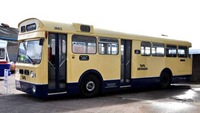 Vehicle reminder shot for this posting
Vehicle reminder shot for this posting
01/01/16 – 16:51
I think the "issues" with the frontal styling arose because the Swift chassis was (at the rear) relatively high, but this one has a low driving position. Hence the correspondingly low positioning of the windscreen, relative to the overall height of the vehicle, which needs to allow for the height of the floor in the rear section.
As David O says above, the Swift and Panther used the same chassis frame, but Swifts had radiators in the side adjacent to the engine, and I believe this caused them to have higher floors at the rear. Other bodybuilders had this problem with Swifts, for example, Southampton’s East Lancs bodied batch numbered 7-10 also had an "extra" section between the windscreen and destination box.
Nigel Frampton
Quick links to the - Comments Page - Contact Page - Home Page
Please leave a comment
Please Note if you want to send a photograph with your comment please use the Contact Page by clicking here or send as an attachment via email.
